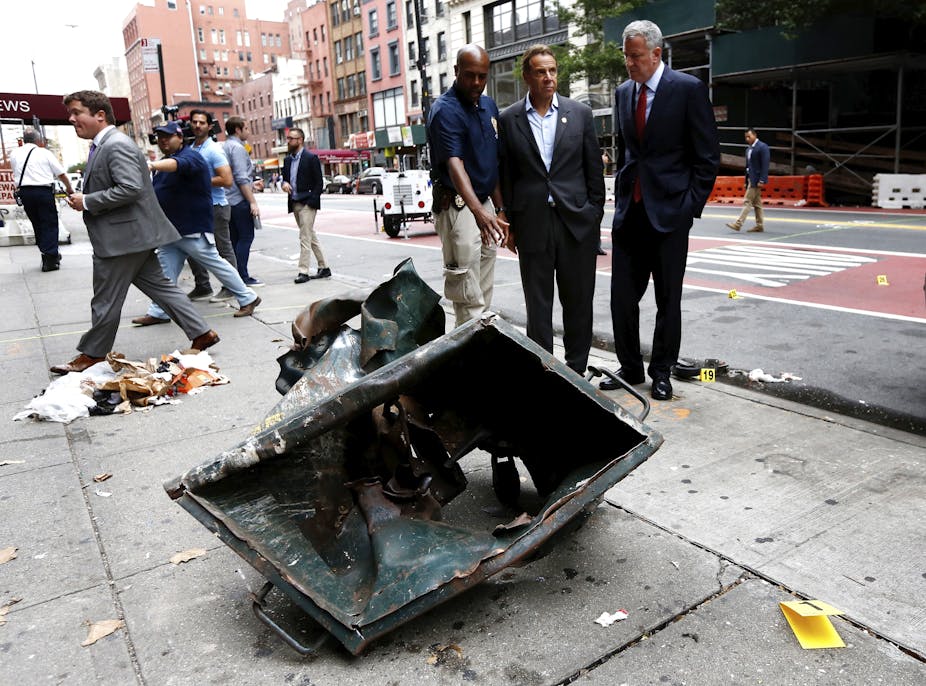The recent attack in New York, which left 29 persons wounded, the bombings in New Jersey and the knife attack in Minnesota serve as a grim reminder that this year of blood and fury carries on.
“We have every reason to believe this was an act of terror,” New York Mayor Bill de Blasio stated Monday afternoon in reference to the bombings and the suspected perpetrator’s Ahmad Khan Rahami’s arrest.
Once again, we confront mayhem for no apparent reason. Attacks in diverse world locations including Paris, Brussels, San Bernardino, Istanbul, Baghdad, Jakarta, Orlando and Dhaka cumulatively compound the sense that the world is chaotic and unsafe. The idea that disaster can strike at any moment anywhere just at someone’s unfathomable whim increasingly insinuates itself into people’s minds.
Though incomprehensible to most, these instances of seemingly rampant violence have a compelling rhyme and reason to the perpetrators. They carry out their carnage in full premeditation and after careful preparation. Theirs isn’t crime of passion, or case of temporary insanity. It is, instead, a deliberately chosen path grounded in a confidently held worldview.
But to what end? And why through violence?
Based on my research, violent extremism typically requires the presence of three elements that jointly create the terrorist mindset: what I call the “N-triad of radicalization.” The three N’s are need, narrative and network.
The first N is individuals’ need, which creates the quest to satisfy it by appropriate means. In the case of violent extremism, that need is one for personal significance, the desire to matter in one’s own eyes and those of significant others. Simply put, it is the universal yearning to have respect.
The second N is the ideological narrative that justifies violence and depicts it as an effective and desirable way to gratify the need.
The third N is the social network that validates the ideology and rewards its adherents.
Human quest for significance
The need, and consequent quest, for significance is typically aroused by a loss or lack of significance in the individual’s life and an opportunity to regain it. The loss may come from personal failure or from an affront to social identity: for instance, an insult to one’s identity as a Muslim, a discrimination against one’s identity as a Palestinian or a disdain aimed at one’s identity as an American.
Personal failure motivates individuals to latch on to their collective identity because it offers them a way to regain their significance by acting on behalf of a collective cause. Indeed, many of the recent attackers were likely unhappy about their personal lives, felt down on their luck and disrespected.
Mohamed Bouhlel, the perpetrator of the July 14 Nice attack, was in the process of getting divorced when he carried out the killings. He had financial problems, and his wife and children refused to see him. His psychological makeup might have been unstable and volatile. According to his father, Bouhlel suffered a serious nervous breakdown when he was younger. He also had multiple previous run-ins with the police for minor charges such as assault and theft.
The San Bernardino attackers, Syed Farook and Tashfeen Malik, seemed happy by most accounts from friends and relatives.

They had just had a baby, and Farook was making a decent salary at work. However, shortly before the attack, Farook told family members that his coworkers had mocked his beard. There were also indications that Farook may have had an unstable family background: His mother filed multiple restraining orders against his father, calling him a mentally ill alcoholic who was continually threatening violence against himself and others.
Akhmed Chatayev, a Chechen, the ringleader of the Istanbul airport attack, was physically disabled: He had only one arm, with sources suggesting that the other was chopped off as part of a torture regimen when he was in prison. He fled Russia as a political prisoner a decade before the Istanbul attack, and subsequently struggled to avoid being extradited back to Russia, where he feared he would likely face an unfair trial, torture and ill treatment.
A recent study of 119 lone-actor militants revealed that more than one-third of them had been diagnosed with mental disorders. Many lived in social isolation. Two-thirds lived alone or away from home, and 69 percent either had never married or had split from their spouse.
Issues of failure, rejection and humiliation surface in nearly all known cases of extremist violence carried out in recent years.

The typical attacker experiences a sense of profound insignificance, and feels mistreated and denigrated by society. The Copenhagen Brothers gang, whose member Omar Abdel Hamid el-Hussein carried out the café and synagogue attacks in the Danish capital, was made up of embittered young men who felt rejected by society.
Cherif and Said Kouachi, perpetrators of the Charlie Hebdo attacks in Paris, were often unemployed and immersed in a life of petty crime and drugs before embracing radical Islam. Tamerlan Tsarnaev, the older, more influential of the Tsarnaev brothers who carried out the Boston Marathon massacre, was rejected by the local state college and had no American friends. His hopes of making the U.S. Olympic boxing team were shattered, and at the time of the bombing, he was an unemployed stay-at-home dad while his wife worked 70 hours a week.
Narrative
The sense of personal inadequacy renders such individuals acutely vulnerable to ideological narratives that justify violence against the alleged detractors of their social group, ethnicity or religion. The narrative’s allure is in its promise of a hero or martyr status, if only they are prepared to sacrifice themselves for the cause. Such appeal may work also on individuals who are doing well by normal standards. They too may find irresistible the glamour and glory of violence for a cause.
A violence-promoting narrative can thus inspire many to take up arms. Yet, it works best on individuals whose sense of personal insignificance makes them especially vulnerable.
The allure of violence
The role of violence as a unique path to personal significance is worth emphasizing. It has an instinctual, primordial appeal. In the evolutionary world, violence has been the ubiquitous mode of settling conflicts and establishing dominance. It is through violence, or the potential for violence, that animals construct their hierarchies, children settle their disputes and sophisticated nations secure their standing in the international pecking order.
Though images of death and destruction wreaked by violence may inspire generations that suffered its consequences to seek peace, subsequent generations to whom the lessons of history are pallid and remote may be vulnerable to the seductive appear of violence.
Because of its directness, immediacy and primordial nature, violence has a special status as a way to achieve significance that often outshines the other methods. Redirecting the quest for significance to constructive, pro-social activities requires thoughtful consideration of how to make those activities appealing to those in search of significance.
Network
Finally, social networks impact individuals’ readiness to kill and die on the altar of a cause. This is because social networks of individuals’ friends and relatives serve two functions. The first function is informational. Simply, the networks validate the person’s views and give them an aura of reality. The second function is motivational, in that by serving the group’s sacred values, individuals receive considerable respect and admiration from other group members.

The role of violent networks has been compellingly documented. Even the so-called “lone wolves” more often constitute “wolf packs,” or groups of men who psych each other up to a state of frenzy. And even in the absence of a physical network, there is invariably a virtual or imagined network. This is an awareness that one acts on behalf of a group that venerates one’s actions, and claims ownership over the exploits of its “heroic” foot soldiers.
Though it might appear random and haphazard, the violence on streets of the world’s cities is psychologically coherent. The combination of individuals’ needs, narratives and networks forms a combustible mixture ready to explode in mayhem and murder. Taking all three elements into account may offer a reasonable, science-based approach to preventing and reversing radicalization. It may be key to interventions and programs that can stem the tide of violent extremism that seriously threatens the world’s security and stability.

